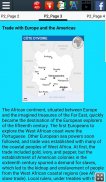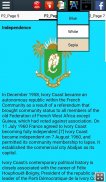








History of Ivory Coast

وصف لـHistory of Ivory Coast
The date of the first human presence in Ivory Coast (officially called Côte d'Ivoire) has been difficult to determine because human remains have not been well preserved in the country's humid climate. However, the presence of old weapon and tool fragments (specifically, polished axes cut through shale and remnants of cooking and fishing) in the country has been interpreted as a possible indication of a large human presence during the Upper Paleolithic period (15,000 to 10,000 BC), or at the minimum, the Neolithic period. The earliest known inhabitants of Côte d'Ivoire, however, have left traces scattered throughout the territory. Historians believe that they were all either displaced or absorbed by the ancestors of the present inhabitants. Peoples who arrived before the 16th century include the Ehotilé (Aboisso), Kotrowou (Fresco), Zéhiri (Grand Lahou), Ega and Diès (Divo).
This app is about history and for research Purpose .





















